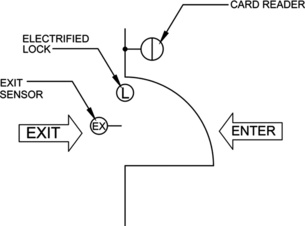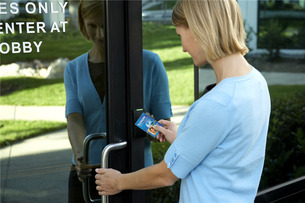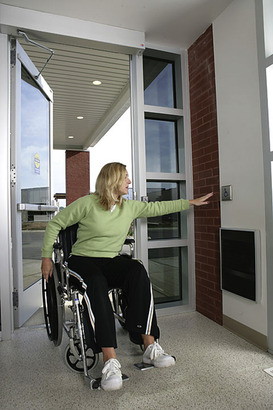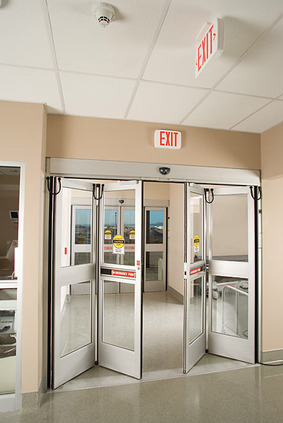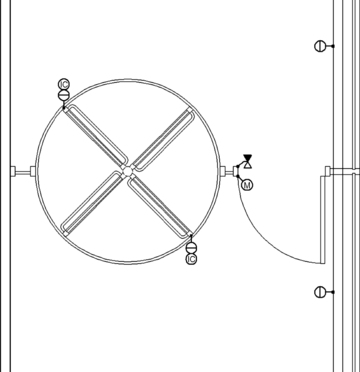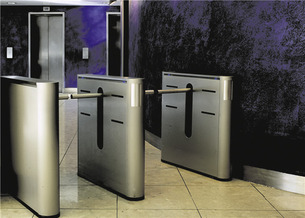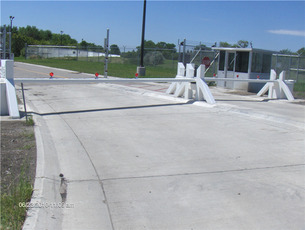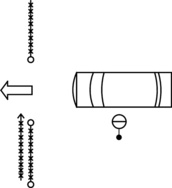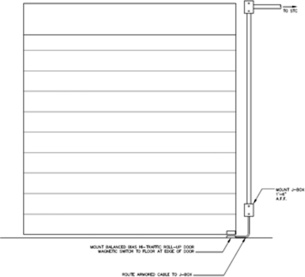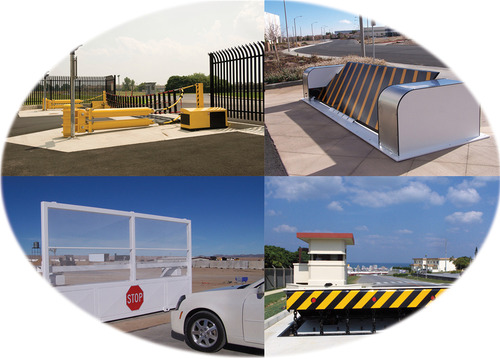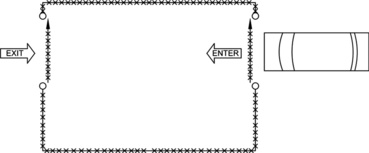5. Types of Access Controlled Portals
Chapter Objectives
1. Learn the Basics in the Chapter Overview
2. Portal Passage Concepts
3. Understand the Most Commonly Used Type — Pedestrian Portals
• Standard Doors
• Automatic Doors
• Revolving Doors
• Turnstiles
• Man-Traps
• Automated Walls
4. Learn about the Other Common Type — Vehicle Portals
• Standard Barrier Gates
• High-Security Barrier Gates
• Sally Ports
5. Pass a Quiz on Types of Access Controlled Portals
CHAPTER OVERVIEW
An Access Portal is a passageway through which a person must pass in order to go from one access zone to another. When an access control portal is confronted, one knows that he is moving from one access area into another. Depending on the security configuration of the portal, access authorization may be required to enter, to leave, or to enter and leave through the portal. In most cases, access can be granted to a single individual, but for some higher security zones, access may require the presence of two or more authorized people. Access portals can be configured to work on a schedule so that access is free during some hours and requires authorization during others, or may be limited to certain individuals during certain hours.
Pedestrian portals include standard doors, automatic doors, revolving doors, turnstiles, Man-Traps, and automated walls. Vehicle portals may include standard barrier gates, high-security barrier gates, and sally ports.
An Access Portal is a passageway through which a person must pass to go from one access zone to another. When an access control portal is confronted, you know you are moving from one access area into another. Depending on the security configuration of the portal, access authorization may be required to enter, to leave, or to enter and leave through the portal. In most cases, access can be granted to a single individual, but for some higher security zones, access may require the presence of two or more authorized people. Access portals can be configured to work on a schedule so that access is free during some hours and requires authorization during others or may be limited to certain individuals during certain hours.
Pedestrian portals include common doors, automatic doors, revolving doors, turnstiles, man-traps, and automated walls. Vehicle portals may include standard barrier gates, high-security barrier gates, and sally ports.
Keywords: Access Zone, Authorization, Doors, Passageway, Portal, Schedule, Turnstiles
Author Information:
Thomas L. Norman, CPP, PSP, CSC, Executive Vice President, Protection Partners International
Portal Passage Concepts
Card Entry/Free Exit
When a person confronts an access controlled portal they must show authorization to pass. The most common form of portal design is one designed to allow entry only to authorized users but also allow anyone inside the access zone to exit freely. This is normally accommodated by using a card reader, keypad, or biometric reader (or some combination of these) to authorize the user to enter. Exit is possible without being an authorized user; that is, any visitor or non-authorized person who was escorted inside by an authorized user is free to exit at any time and without any impediment. A typical portal has a locking system that must be unlocked in order to exit. Various Request-to-Exit sensors may be used including an Exit Push Button, Panic Exit Touch-Bar, or a motion detector over the door (Figure 5.1).
Card Entry/Card Exit
Another common portal configuration uses a Credential Reader on both sides of the door. This variation helps ensure that people are accounted for as they enter and leave an area. It is common to see this type of portal in areas where either financial instruments or proprietary information is controlled, such as in a cash-counting room or archive room. When using this type of portal, it is imperative to ensure that the door can be opened in an emergency without requiring a credential, which might not be immediately available. It is common to interface the locking mechanism on Card In/Out portals with the Fire Alarm System and also mount an Emergency Door Release next to the Exit Reader so that occupants can exit the door in a fire or other type of emergency.
Tailgate Detection
An aggravating problem related to access control portals is the issue of “Tailgating” (Figure 5.2). Tailgating is the practice of an unauthorized user following an authorized user through an access controlled door by catching the door before it fully closes and sneaking in behind the authorized user.
This can be reduced by using a Tailgate Detection System that places a pair of infrared beams across the width of the door and allows one passage through in the direction of the authorized entry. The beams comprise a set of infrared emitters and receivers that are stacked vertically to prevent an unauthorized person from crawling under or jumping over the beams; better systems also stack the beams horizontally so that the system can detect the direction of travel. These systems allow one person to pass freely but sound a local alarm at the door if a second person also tries to enter behind the authorized user. If a visitor is to be escorted into the space by an authorized user, the valid card is presented first for the visitor who enters separately from the authorized user.
Positive Access Control
The best way to prevent tailgating is to use a principle called “Positive Access Control.” This method ensures that tailgaters will not abuse the access control system by providing a physical means to allow one user through a portal for each time a credential is presented to a credential reader. This can be achieved using an electronic turnstile (Figure 5.3), a revolving door or a man-trap (for pedestrians), or a sally port (for vehicles).
Such applications are often needed in high-traffic areas where a significant number of unauthorized people could enter. In such applications, an electronic turnstile is a good method to maintain high traffic flow (up to one person per second with some models) while still ensuring one passage per credential. It is also important in such applications to use high-speed credentials such as a proximity card or contactless smart card.
2-Man Rule
Where a very high security zone exists, such as for a nuclear missile silo or gold or currency vault in a central bank where billions of dollars in gold or currency may be stored, or where credit cards are being manufactured, or integrated circuit central processing unit chips are in bulk storage (which are worth more than their weight in gold), it is common to see a 2-Man Rule applied to the access door. The 2-Man Rule requires two people, usually one employee and one manager or two managers, to present their authorized credentials to a single card or biometric reader within a certain minimum time (such as within 30 seconds). The 2-Man Rule ensures that no single person ever has access to the secured area alone, thus providing a higher level of security by ensuring that one person will always be watching another.
Schedules
Organizations do not operate a single shift 24 hours per day, 365 days per year. They typically operate a day shift, evening shift, and night shift. Holidays, weekends, and special events also change the normal routine of every organization. Some organizations, notably offshore oil rigs, do not operate on a 7-day calendar schedule at all, but rather on a 10 day on/10 day off or similar schedule frequently with 12-hour instead of 8-hour shifts. The electronic access control system must adapt and accommodate all of these diverse schedules.
A normal system is set up with a number of different schedules, all working together:
• 24/7/365 (24 hours per day, 7 days per week, 365 days per year — all hours)
• Daytime working hours
• Evening working hours
• Nighttime working hours
• Weekend hours
• Holidays
• Special Event (unique schedule for each event)
Anti-Passback
As discussed in Chapter 2, Anti-Passback schemes are designed to prevent one authorized user from allowing his card to be used by a second unauthorized person. Anti-Passback schemes set up an Anti-Passback Zone that is bounded by Access Control Portals. The Access Control Portals are included in the Anti-Passback Zone so that an authorized user must enter the zone and exit it again (from the same or another portal in the Anti-Passback Zone) before his card can be used again to enter. The same card cannot be used twice in a row to enter. Once in, once out, then in again. This way, the authorized user who passes his card back to an unauthorized visitor will find that the card will not allow the visitor to enter because the card has not been used to exit.
Anti-Passback Portals must be configured as Card In/Card Out to keep track of each individual passage by each individual authorized user. Anti-Passback works best with Positive Access Control portals, where an authorized user cannot exit with a group, forgetting to use his card to go out, thus leaving him outside with no way back in.
Pedestrian Portal Types
Standard Doors
The standard door is the basic unit of an electronic access control system. Simple to understand, commonplace, and inexpensive, wherever there is a room or department to secure in most cases you can bet that it already has a standard door enclosing it. Standard doors are intuitive (everyone knows how to use one) and can allow for the passage of one or more users at a time.
A typical standard door access control portal comprises a door (single- or double-leaf) with hinges and door handle hardware; an electrified lock; a card reader, keypad, or biometric reader; one or two door position sensors to tell the system if the door is open or closed; and a request-to-exit sensor. These devices report to an access control panel that may be located near the door or centrally in a utility room.
Typically the request-to-exit sensor is not a credential reader, so the system does not know which authorized user has left the secured space, only that someone has left.
The most obvious problem with standard doors is that they allow any number of people to enter, once opened. Only one authorized user is required to open the door and there is no way for the system (thus the organization) to know if other persons entering were authorized or not. Accordingly, standard doors should not be used for high-security areas unless there are other sound procedures to ensure that each person entering is authorized.
Additionally, this deficiency makes tracking of authorized users difficult. The system cannot know for certain where any given authorized user is located. It knows that a given authorized user has entered, but cannot know that he/she has left and would not know if he/she has entered into the same space again, or perhaps another space by entering with a group when the door was opened by a single authorized user.
Standard doors can be configured for Card In/Free Out or Card In/Card Out and can be configured with a Tailgate Detector to deter the entry of multiple people on a single card; but a single door cannot be configured for positive access control. A single door can be used as part of an Anti-Passback Zone if it is equipped for Card In/Card Out and there is good access control procedural discipline to ensure that two people do not leave the zone under use of a single card (Figure 5.4).
Automatic Doors
In high traffic areas, or where materials must be moved, it is common to use an automatic door. Automatic doors are used in hospitals where patients must be moved in to or out of an Intensive Care Unit, or for materials handling areas where a worker must move a cart of materials to a secure area for printing, such as in a credit card printing shop.
Automatic doors should not be used as a portal to a high-security zone unless there are very good procedural controls, because it is too easy for an unauthorized person to enter behind an authorized person.
The most common type of automatic door is the one- or two-leaf swing door. This is a standard single- or double-leaf door that has an automatic door operator attached to it. Before automating a standard door, it is important to ensure that the frame, hinges, and door are robust enough to stand up to the torque applied by the automatic operator at the top of the door. Remember, this action is applied to an area of the door that does not usually get pressure applied to it. Typically a door is made to be opened at the handle, not at the top. Opening a door from the top, midway between hinge and strike edge, applies considerable pressure that the door was not designed to accept. Accordingly, the door must be sturdy enough to withstand such action many times a day for many years. Lesser doors and doors that are in poor maintenance can fail when an automatic operator is installed.
The operation of an automatic swing door can be a surprise to a person who does not expect it (Figure 5.5). It is advisable to paint or mark “door sweep zones” onto the floor to show where the door will open and as an alert to stay out of that area so that the door does not swing into the path of a person who is standing or walking there. This is especially true when an automatic door will open into a hallway where people are passing by.
Anotkher common type of automatic door is the sliding door (Figure 5.6). Automatic sliding doors are in many ways superior to automatic swing doors because there is no need to be concerned about the door swinging into the path of a person walking nearby. Sliding doors may be manufactured of steel or glass (I have even once seen a wooden door, but that is rare). Sliding doors have the distinct advantage of taking very little space in the room so that furniture or equipment may be located nearby.
Automatic sliding doors may be configured either as a single-leaf where one door slides to the side or double-leaf where two doors slide to the side and then close to the center of the opening. Most automatic sliding door operators provide very little resistance to pulling the door open. This is especially true on double-sliding automatic doors using frameless glass panels. It is all too easy to place one's fingers between the glass panels and peel the doors open. All automatic sliding doors used in access control applications should be equipped with magnetic locks to ensure that the door cannot be pried open by an unauthorized user. However, provisions must be made for opening in an emergency such as a fire, since one cannot simply push the door open unless the door is especially manufactured to have a swing partition hanging from a sliding frame. This is somewhat rare but is an option from some manufacturers.
Another common type of automatic door is the bi-fold or 4-fold door. A bi-fold door is a double-leaf door in which one leaf is hinged to the frame at one side and both leaves are hinged where they come together in the center. The unhinged edge of the final leaf is set in a track at the top of the door so that the entire assembly may be pushed to the side of the leaf that is hinged to the frame. Thus, the bi-fold door folds in half to the side of the opening. Bi-fold doors are typically configured as half-width doors placed across a single door opening. A 4-fold door is simply two bi-fold doors placed across a double-width opening (Figure 5.7).
Bi- and 4-fold doors, like sliding doors, open close to the frame and do not take up much space like a swing door does. Bi- and 4-fold doors open and close quickly, which is their greatest asset. Bi-fold doors open twice as fast as a standard single-leaf sliding door across the same frame. A 4-fold door opens four times as fast as a single-leaf sliding door across a double frame.
Revolving Doors
Where space is available and speed of throughput is not such an issue, Revolving Doors offer a good solution (Figure 5.8). Use of Revolving Doors for Positive Access Control ensures that no person or package can be easily passed through the portal. Use of a revolving door for Positive Access Control requires the addition of an adjacent emergency exit door activated by the fire alarm system and equipped with an emergency door release that is similar to a fire-alarm pull station but marked Emergency Door Release. These are usually colored blue to ensure that no one assumes it is a fire-alarm pull station.
Like the turnstiles, a card reader is placed on each side of the door and allows a 180-degree turn to pass a single individual. Designs vary. The simplest versions allow two or more tightly crammed people to wedge their way through on a single card entry in the same direction (in or out). Better designs ensure that only one person is occupying the revolving door. All types typically have provisions (usually a floor sensor) to ensure that two people are not using the door at the same time in opposite directions.
Where the area is extremely sensitive, a Man-Trap can be used. A Man-Trap is a series of two doors configured so that only one can open at a given time. This way, an authorized user can enter the outer door that closes behind him/her and when both doors are again closed, the user can present his/her credential to the second internal reader, which then opens the inner door. The operation is reversed to exit. In many cases only an exit push button is used to release the outer door for exiting.
Turnstiles
Turnstiles have been around in mechanical form for about a hundred years. You have seen so-called tripod turnstiles (these have three arms that pivot) used in sports arenas, subways, and amusement parks for many years. In corporate lobbies, turnstiles are often configured as a pair of paddles or glass wings enclosed in a confined pathway. Electronic turnstiles come in a variety of types. Those most often used for Positive Access Control are either a set of “paddles” or “glass wings” that physically prevent passage without use of an authorized credential (Figure 5.9).
The simplest type of electronic turnstiles uses only electronic beams and a circuit to sound an alarm if an unauthorized user tries to pass. This type is of no use for Positive Access Control as it presents no physical barrier. Even the paddle and glass wing types should be used under observation of a security officer to ensure that offenders do not jump over or duck under the paddles or jump between turnstiles using glass wings. All of these actions have occurred in actual installations. For observed public areas such as main lobbies, turnstiles are a good choice because of their speed of throughput and safety provisions. Electronic Paddle Turnstiles are also often equipped with break-away arms so that crowds of people can exit quickly in an emergency.
Man-Traps
A Man-Trap is a series of two doors on each end of a vestibule where only one door can be opened at any time. Entry is made by sequencing through the two doors: first the outer door opens and then closes, and then the inner door opens, then closes. Exiting is done in the opposite sequence. The doors are electrically locked and interfaced such that only one door may open at a time. This ensures that no unauthorized person can enter behind an authorized user by closing the outer door before the inner door can open so that the authorized user can be certain that he/she is not being followed (Figure 5.10).
Man-Traps have serious life-safety implications that must be addressed. This typically includes a fire-alarm system interface and emergency pull-stations on the secure side of both doors that override the Man-Trap security function. Typically, pulling the inner emergency door release unlocks both doors, and pulling the outer door emergency lock release unlocks only the outer door. It is imperative to seek a variance with local code authorities before using a Man-Trap to ensure that all local life-safety codes and regulations apply. Note: More and more municipalities do not allow any type of Man-Trap, so it is especially important to check before designing or building one.
Automated Walls
A rare but useful type of access control portal is the Automated Wall. Automated Walls are not used for conventional access control; they are used to prevent the spread of fire throughout a building and to prevent a specific type of attack on certain types of facilities. Automated Walls are high-security elements designed to protect people during a so-called “moving shooter” attack, such as happened in Mumbai in December 2008.
An Automated Wall is placed between areas of the facility, making certain that there is a ready fire exit on both sides of the wall. Placement is critical to comply with fire codes to be certain that the designer is not creating a “dead-end corridor.” In case of a fire or moving shooter emergency, the automated walls are triggered. This compartmentalizes the facility into horizontal segments, preventing the spread of the fire or the movement of the shooter. In the case of the moving shooter attack scenario, this confines the shooter into a controllable space that can bring the event to a much swifter end with far less potential loss of life.
Automated Walls are operated automatically by the fire alarm system or manually from a Security Command Center. They are typically configured to require two keys to operate to ensure that they are not accidentally or haphazardly deployed.
Vehicle Portals
Standard Barrier Gates
Vehicles need to be controlled on a property to ensure proper traffic flow (employees here, visitors there, etc.) and to control entry to restricted areas, such as to an employee parking structure. The least expensive and most familiar way to do this is by using a standard lift-arm barrier gate. Lift-arm (or semaphore arm, named after the semaphore flags that were used to guide airplanes onto aircraft carriers) barrier gates come in a variety of configurations depending on the width of the lane and the frequency of opening. The simplest semaphore arm gate comprises a metal stand housing the motor and operating electronics and a gate arm made of wood, aluminum, or PVC plastic (Figure 5.11).
Semaphore arm gates are typically used in conjunction with a card reader or parking ticket dispenser to open the gate and also to incorporate safety features including:
• A safety edge on the arm to reverse its direction in case it strikes a vehicle, person, or object while descending
• Buried vehicle loops that detect the presence and position of one or more vehicles including:
• A presence-sensing Entry Loop at the card reader or ticket dispenser to ensure that the gate is not deployed up when there is no vehicle to enter
• A safety loop under the arm to prevent it from beginning its descent when a vehicle is present
• An after-presence-sensing Exit Loop to trigger the arm to descend after a vehicle has passed through the gate
The buried loops work in conjunction with a vehicle Loop Detector usually housed in the enclosure that houses the motor. The Loop Detector senses the loops and operates by a logic function to operate the gate in response to signals from the loops, a Card Reader or ticket dispenser, or a remote trigger from the Security Command Center.
It is common to associate a Field Intercom Station with a Card Reader at a Parking Gate so that if a visitor requires assistance the gate can be opened remotely from a Security Command Center where the intercom call is answered. It is also common to associate a video camera viewing the vicinity of the gate and often also the license plate of the car and the face of the driver (three cameras), which are displayed when the driver presses the intercom call button.
Automated Vehicle Swing Gates
Vehicle Swing Gates are often found at residences and commercial or industrial facilities and are used to control the entry and exit of vehicles to/from the property (Figure 5.12). A Swing Gate Operator is mounted to a concrete pad and operates an articulating arm or hydraulic ram that opens and closes the gate. These are also normally operated by a Card Reader or remotely from a facility in conjunction with an intercom. It is common to utilize vehicle loops for safety. Card Readers for Automated Vehicle Swing Gates are often set back an additional distance to allow for the swing of the gate, so the entire gate and queuing area can become somewhat large. The open/close time of a standard lane-width gate is about 20 seconds. Where the door is used as a security element, it may be advisable to add a magnetic lock to ensure that the door cannot be easily forced open against the operator by potential intruders. This also helps to prevent damage to the operator, which can occur if the door is forced open.
Automated Sliding Vehicle Gates
Another common type of vehicle portal is the Sliding Vehicle Gate (Figure 5.13). Automated Sliding Gates use a Sliding Gate Operator and a long chain near the lower part of the sliding gate. The chain is held at both ends of the sliding gate and feeds through a gear on the gate operator. As the gate operator rotates its motor, the chain is moved along and it moves the gate, which is attached to the chain.
Sliding gates, like sliding doors, have the advantage of taking very little driveway space, so they are especially useful on sloping driveways where a swing of the gate would conflict with the oncoming vehicle or where it would conflict with the slope of the driveway. All other aspects of Automated Sliding Vehicle Gates are similar to Automated Vehicle Swing Gates. Sliding gates are also usually equipped with safety edges to prevent them from closing on a vehicle, person, or object. Sliding gates are also ideal where it is desirable to locate the Card Reader closer to the gate because there is no setback for the swing of the gate, so they often work better in confined areas. The operating time of Automated Sliding Gates is similar to Swing Gates — about 20 seconds.
Automated Roll-up Vehicle Gates
Roll-up Vehicle Gates are most often seen at a vehicle entry to a building, although they are also used at fence lines in high-security facilities, most notably at detention facilities (Figure 5.14). Roll-up doors are more difficult to break into than either swing or sliding gates.
High-Security Barrier Gates
High-Security Barrier Gates are used to prevent crash-through entries into secure facilities such as ports and nuclear facilities (Figure 5.15).
Crash-rated gates are available in a variety of designs including:
• Lift-Arm Barrier Gates
• Sliding Gates
• Web Fabric Gates
• Phalanx Gates
• Rising Bollards
• Uncommon miscellaneous types
Sally Ports
Sally ports are a secure, controlled entryway for vehicles having two gates, similar to a Man-Trap in operation (Figure 5.16). The entrance is typically part of an outer perimeter such as a secure fence line or prison perimeter wall and the interior gate is also fortified against easy entry. Sally ports are operated remotely by a Security Officer from a separate secure space where he/she can supervise the entry and exit. Only one sally port door is ever opened at a time to ensure that no one can sneak in (to a military compound) or out (for a prison).
Chapter Summary
1. Basic Portal Passage Concepts include:
• Card Entry/Free Exit
• Card Entry/Card Exit
• Tailgate Detection
• Positive Access Control
• 2-Man Rule
• Schedules
• Anti-Passback
2. Common Pedestrian Portal types include:
• Standard Doors
• Automatic Doors
- Automatic Swing Doors
- Automatic Sliding Doors
- Automatic 4-Fold Doors
• Revolving Doors
• Turnstiles
• Man-Traps
• Automated Walls
3. Common Vehicle Portal types include:
• Standard Barrier Gates
- Semaphore Arm Barrier Gates
- Automated Vehicle Swing Gates
- Automated Vehicle Sliding Gates
- Automated Roll-up Vehicle Gates
• High-Security Barrier Gates
• Sally Ports
1) What is an access portal?
a. System network access
b. Organization's security program
c. Authorization given to access higher security zones
d. Passageway through which a person must pass to go from one access zone to another
2) Card Entry/Card Exit
a. Is designed to allow entry only to authorized users but allows anyone inside the access zone to exit freely
b. Is designed to allow entry only to authorized users and to allow exit with authorization inside the access zone
c. Is the practice of an unauthorized user following an authorized user through an access controlled door by catching the door before it closes
d. Ensures no single person ever has access to the secured area alone, thus providing a higher level of security by ensuring that one person will always be watching another
3) Tailgate Detection
a. Is designed to allow entry only to authorized users but allows anyone inside the access zone to exit freely
b. Is designed to allow entry only to authorized users and to allow exit with authorization inside the access zone
c. Is the practice of an unauthorized user following an authorized user through an access controlled door by catching the door before it closes
d. Ensures no single person ever has access to the secured area alone, thus providing a higher level of security by ensuring that one person will always be watching another
4) 2-Man Rule
a. Is designed to allow entry only to authorized users but allows anyone inside the access zone to exit freely
b. Is designed to allow entry only to authorized users and to allow exit with authorization inside the access zone
c. Is the practice of an unauthorized user following an authorized user through an access controlled door by catching the door before it closes
d. Ensures no single person ever has access to the secured area alone, thus providing a higher level of security by ensuring that one person will always be watching another.
5) Anti-Passback schemes are designed to prevent one authorized user from allowing his card to be used by a second unauthorized person
a. True
b. False
6) Standard Doors
a. Used in high traffic areas, or where materials must be moved
b. Is the basic unit of an electronic access control system
c. Configured as a pair of paddles or glass wings enclosed in a confined pathway
d. Series of two doors on each end of a vestibule where only one door can be opened at any time
7) Automatic Doors
a. Used in high traffic areas, or where materials must be moved
b. Is the basic unit of an electronic access control system
c. Configured as a pair of paddles or glass wings enclosed in a confined pathway
d. Series of two doors on each end of a vestibule where only one door can be opened at any time
8) Turnstiles
a. Used in high traffic areas, or where materials must be moved
b. Is the basic unit of an electronic access control system
c. Configured as a pair of paddles or glass wings enclosed in a confined pathway
d. Series of two doors on each end of a vestibule where only one door can be opened at any time
9) Man-Traps
a. Used in high traffic areas, or where materials must be moved
b. Is the basic unit of an electronic access control system
c. Configured as a pair of paddles or glass wings enclosed in a confined pathway
d. Series of two doors on each end of a vestibule where only one door can be opened at any time
10) Automated Vehicle Swing Gates
a. Often found at residences and commercial or industrial facilities and are used to control the entry and exit of vehicles to/from the property
b. Least expensive and most familiar way to control entry to restricted areas
c. Used to prevent crash-through entries into secure facilities such as ports and nuclear facilities
d. Commonly operated remotely by a Security Officer from a separate secure space where he/she can supervise the entry and exit
11) Sally Ports
a. Often found at residences and commercial or industrial facilities and are used to control the entry and exit of vehicles to/from the property
b. Least expensive and most familiar way to control entry to restricted areas
c. Used to prevent crash-through entries into secure facilities such as ports and nuclear facilities
d. Commonly operated remotely by a Security Officer from a separate secure space where he/she can supervise the entry and exit
12) Standard Barrier Gates
a. Often found at residences and commercial or industrial facilities and are used to control the entry and exit of vehicles to/from the property
b. Least expensive and most familiar way to control entry to restricted areas
c. Used to prevent crash-through entries into secure facilities such as ports and nuclear facilities
d. Commonly operated remotely by a Security Officer from a separate secure space where he/she can supervise the entry and exit
13) High-Security Barrier Gates
a. Often found at residences and commercial or industrial facilities and are used to control the entry and exit of vehicles to/from the property
b. Least expensive and most familiar way to control entry to restricted areas
c. Used to prevent crash-through entries into secure facilities such as ports and nuclear facilities
d. Commonly operated remotely by a Security Officer from a separate secure space where he/she can supervise the entry and exit
Answers: 1) d, 2) b, 3) c, 4) d, 5) a, 6) b, 7) a, 8) c, 9) d, 10) a, 11) d, 12) b, 13) c
..................Content has been hidden....................
You can't read the all page of ebook, please click here login for view all page.

